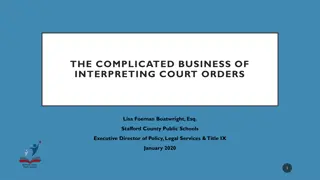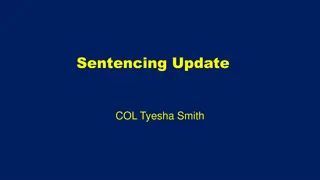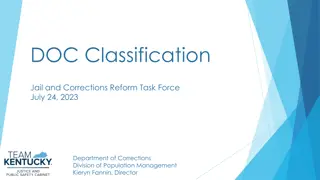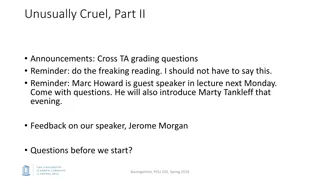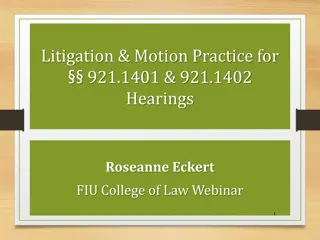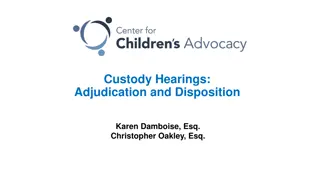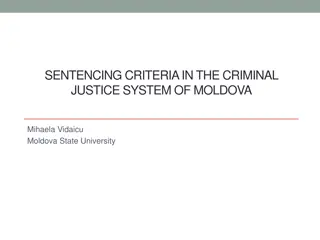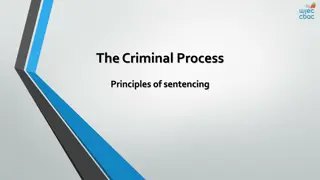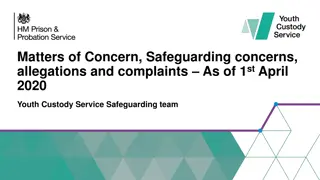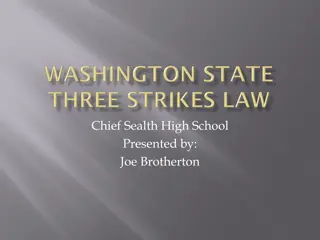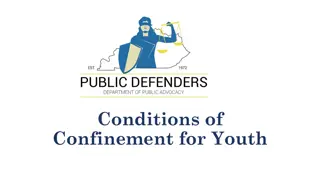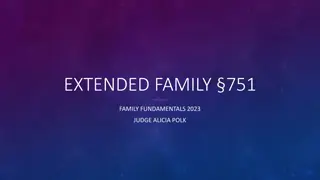Understanding Sentencing Practices and Primary Custody in Legal System
This educational presentation by the U.S. Sentencing Commission Office covers essential concepts such as primary custody, concurrent vs. consecutive sentences, and determining the applicability of departures and variances in sentencing. It also discusses a scenario involving multiple sentences for a defendant and the significance of primary custody in determining which jurisdiction's sentence takes precedence.
- Sentencing practices
- Legal system
- U.S. Sentencing Commission
- Primary custody
- Concurrent vs. Consecutive
Download Presentation

Please find below an Image/Link to download the presentation.
The content on the website is provided AS IS for your information and personal use only. It may not be sold, licensed, or shared on other websites without obtaining consent from the author. Download presentation by click this link. If you encounter any issues during the download, it is possible that the publisher has removed the file from their server.
E N D
Presentation Transcript
Determining the Sentence May 12, 2022 U.S. Sentencing Commission Office of Education and Sentencing Practice This presentation is produced and disseminated at U.S. taxpayer expense.
Learning Objectives Your active engagement in this section will empower you to: Apply the rules for undischarged, anticipated, and discharged sentences; Describe the three-step sentencing process; and Evaluate the applicability of departures and variances.
Multiple Sentence Problem Loren Baker is currently serving a state sentence for sale of methamphetamine. After being sentenced in state court, the federal government charges her with conspiracy to distribute methamphetamine. The charged conspiracy is broader than, but includes, the sale of methamphetamine in state court. Your goal is to have her entire state sentence count toward the federal sentence.
Essential Concepts Primary Custody Concurrent/Consecutive BOP Sentence Computation Undischarged, Discharged, and Anticipated Sentences
Primary Custody The first sovereign to arrest the defendant has primary custody. Sovereign may relinquish through: bail dismissal granting parole sentence completion A writ is NOT a relinquishment of primary custody.
Loren Baker is currently serving a state sentence for sale of methamphetamine. After being sentenced in state court, the federal government charges her with conspiracy to distribute methamphetamine. The charged conspiracy is broader than, but includes, the sale of methamphetamine in state court. Who has primary custody? A. The State B. The Feds
Primary Custody Matters The sentence in the jurisdiction with primary custody must be served first. Concurrent? The sentencing judge in the other jurisdiction determines when the other sentence begins. Partially Concurrent? Consecutive?
In our case, does the federal judge or state judge determine whether the sentences run concurrently or consecutively? A. Federal judge B. State judge
Calculation of Imprisonment Term 18 U.S.C. 3585(a) A sentence begins when the defendant: is in custody awaiting transportation to serve the sentence; or arrives voluntarily to commence service of sentence.
BOP Custody Credit 18 U.S.C. 3585(b) Official Detention: for any other charge not credited to another sentence or for the instant offense
Loren Baker is currently serving a state sentence for sale of methamphetamine. After being sentenced in state court, the federal government charges her with conspiracy to distribute methamphetamine. The charged conspiracy is broader than, but includes, the sale of methamphetamine in state court. Will the BOP credit Ms. Baker the time that she spent incarcerated before the date of her federal sentencing? A. Yes B. No
Undischarged Sentence 5G1.3(b) a b R U L E R U L E Defendant Committed Offense in Prison Undischarged Sentence / Relevant Conduct c d R U L E R U L E Anticipated State Sentence / Relevant Conduct Catch-all Provision
5G1.3(b) Concepts Must be relevant conduct under 1B1.3(a)(1), (a)(2), (a)(3). This mechanism should be noted clearly on the judgment. Must order remaining period to be served concurrently. Must be an undischarged term. Must adjust sentence by time not credited by BOP. May adjust below mandatory minimum.
Multiple Sentence Problem Loren Baker Term already served Time Remaining to Serve 12 Months 12 Months State Sentence Concurrent to State Sentence 63 Months 51 Months Federal Sentence
Discharged Terms of Imprisonment 5K2.23 (p. 485) Downward departure if: 1. Defendant completed sentence of imprisonment; AND 2. 5G1.3(b) would have applied otherwise.
Undischarged and Anticipated 5G1.3 a b R U L E R U L E Defendant Committed Offense in Prison Undischarged Sentence / Relevant Conduct c d R U L E R U L E Anticipated State Sentence / Relevant Conduct Catch-all Provision
Catch-All Provision a b R U L E R U L E Defendant Committed Offense in Prison Undischarged Sentence / Relevant Conduct c d R U L E R U L E Anticipated State Sentence / Relevant Conduct Catch-all Provision
3-Step Approach to Federal Sentencing Guidelines Departures Variances
20 Statement of Reasons
Departures 1B1.1, App. Note 1(F) (p. 18) Downward Departure GL Range A sentence outside of, or different from, the Guidelines range; or 24mo 12mo 21mo 15mo Upward Departure An assignment of a different criminal history category under 4A1.3. III III
In FY 2020, what is the most cited basis for a downward departure? A. Criminal History B. Substantial Assistance C. Early Disposition D. Family Ties
23 Top 10 Reasons for Departure Fiscal Year 2021 1. Early disposition program 2. Substantial assistance with government motion Downward Departure 3. The history and characteristics of the defendant 4. Criminal history 5. General mitigating circumstances 6. Family ties responsibilities 7. Reflect seriousness of offense/promotes respect for law just punishment 8. Afford adequate deterrence to criminal conduct 9. COVID-19/pandemic 10. The nature and circumstance of the offense
Variance 1B1.1, Background (p. 20) A sentence imposed outside of the guidelines framework. Guidelines Framework Downward Departure 30mo GL Range Downward Variance 24mo Upward Variance 12mo 21mo 15mo Upward Departure 6mo
18 U.S.C. 3553(a) The court shall impose a sentence sufficient, but not greater than necessary, to comply with the purposes of Punishment Deterrence Purposes Incapacitation Rehabilitation sentencing.
History and Characteristics Nature and Circumstances of the Offense Restitution What else must a court consider? Unwarranted Sentencing Disparities Purposes of Sentencing 3553(a)(1)-(7) Policy Statements Kinds of Sentences Guidelines
27 Top 10 Reasons for Variance Fiscal Year 2021 1. The history and characteristics of the defendant 2. Reflect seriousness of offense/promotes respect for law just punishment 3. Afford adequate deterrence to criminal conduct Downward Variance 4. The nature and circumstance of the offense 5. Protect public from further crimes 6. Criminal history issues 7. Family ties responsibilities 8. Avoid unwarranted sentencing disparity 9. Drug dependence/alcohol abuse 10. Age
Defendant and Family Interviews Medical Records/Evaluations Mental Health Treatment Supporting Departures Substance Abuse Treatment and Educational Records Variances Military Service Records Employment Records Financial Records
Learning Outcomes You should now be able to: Apply the rules for undischarged, anticipated, and discharged sentences; Describe the three-step sentencing process; and Evaluate the applicability of departures and variances.
Questions or Comments? WWW www.ussc.gov @theusscgov HelpLine |(202) 502-4545 training@ussc.gov







